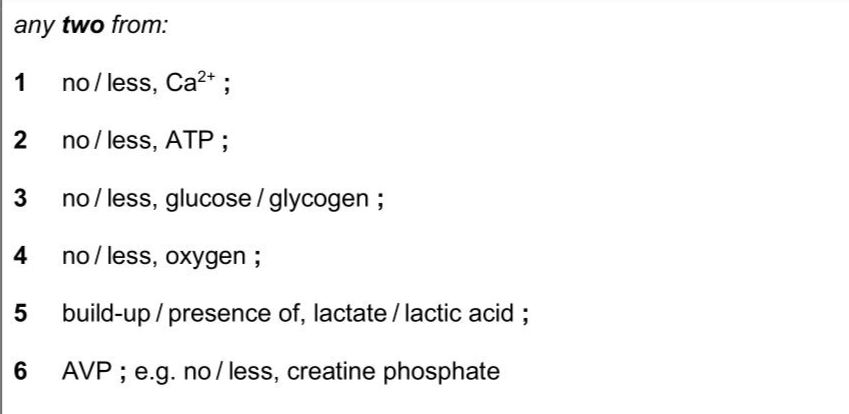Striated muscles can sometimes become less efficient at contracting if they have been active for a long time. This is called muscle fatigue. Suggest why muscles may become fatigued. . . . . . .
Exam No:9700_s25_qp_44 Year:2025 Question No:8(c)
Answer:

Knowledge points:
14.2.1 explain that stomata respond to changes in environmental conditions by opening and closing and that regulation of stomatal aperture balances the need for carbon dioxide uptake by diffusion with the need to minimise water loss by transpiration
14.2.2 explain that stomata have daily rhythms of opening and closing
14.2.3 describe the structure and function of guard cells and explain the mechanism by which they open and close stomata
14.2.4 describe the role of abscisic acid in the closure of stomata during times of water stress, including the role of calcium ions as a second messenger
15.1.1 describe the features of the endocrine system with reference to the hormones ADH, glucagon and insulin (see 14.1.8, 14.1.9 and 14.1.10)
15.1.10 describe the roles of neuromuscular junctions, the T-tubule system and sarcoplasmic reticulum in stimulating contraction in striated muscle
15.1.11 describe the ultrastructure of striated muscle with reference to sarcomere structure using electron micrographs and diagrams
15.1.12 explain the sliding filament model of muscular contraction including the roles of troponin, tropomyosin, calcium ions and ATP
15.1.2 compare the features of the nervous system and the endocrine system
15.1.3 describe the structure and function of a sensory neurone and a motor neurone and state that intermediate neurones connect sensory neurones and motor neurones
15.1.4 outline the role of sensory receptor cells in detecting stimuli and stimulating the transmission of impulses in sensory neurones
15.1.5 describe the sequence of events that results in an action potential in a sensory neurone, using a chemoreceptor cell in a human taste bud as an example
15.1.6 describe and explain changes to the membrane potential of neurones, including:
15.1.7 how the resting potential is maintained
15.1.8.1 how the resting potential is restored during the refractory period
15.1.8.2 describe and explain the rapid transmission of an impulse in a myelinated neurone with reference to saltatory conduction
15.1.8.3 explain the importance of the refractory period in determining the frequency of impulses
15.1.9 describe the structure of a cholinergic synapse and explain how it functions, including the role of calcium ions
Solution:
Download APP for more features
1. Tons of answers.
2. Smarter Al tools enhance your learning journey.
IOS
Download
Download
Android
Download
Download
Google Play
Download
Download
